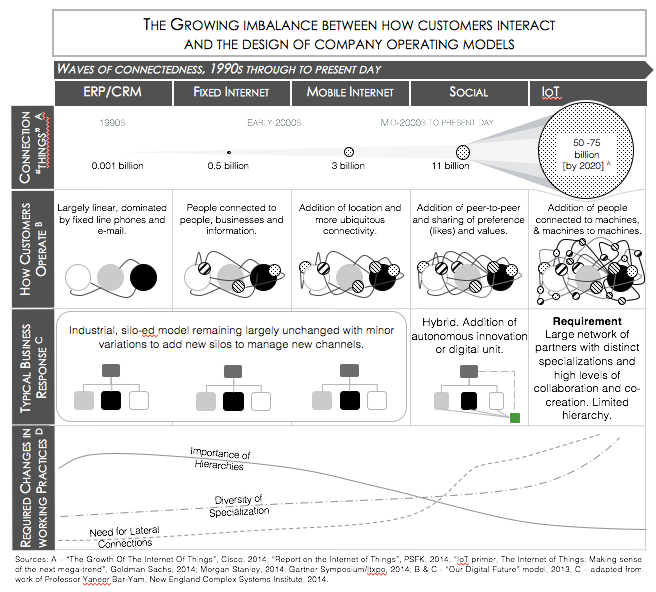The Next Wave of Connectedness
The idea of the Internet of Things (IoT) has been around since 1999 (ref. Kevin Ashton), though it’s garnered more interest recently as the cost of sensors have dropped, and the introduction of IPv6 standards and near ubiquitous internet, have allowed almost anything to be connected. From trash cans and buses, to cars and homes, and even cows and dogs. By 2020 it’s estimated that there will be at least 50 billion connected “things” (see this video infographic).
Though it’s not the data that these “things” generate that’s the exciting part. It is isn’t even the control and optimization of systems that this new information allows that’s incredible (though this does create a huge range of new possibilities). It’s what you can do with the data once inanimate objects can monitor their own state and the world around them. It’s the combination of this data with a series of IF – THEN statements that enable a near infinite number of complex decisions to be automated Frictionlessly (without human intervention) by machines. This is a significant fulcrum point in our Digital Future; the point at which machines create more data than humans and are able to replace us for many cognitive tasks.
The Pressure of Imbalance
Whilst we still have technical issues like security, interoperability and privacy to address with the IoT, it’s not these that will put the greatest strain on businesses. It’s the fact that customers have been far better at responding to increased level of Connectedness than companies. If we take a look back (see figure), as each successive wave of increased Connectedness has hit, customers have changed the way they interact, use devices and organize themselves. In stark contrast, businesses have generally been much slower. For example, use of enterprise social is still limited, adoption of enterprise mobility has been slow, and silo-ed (Industrial Age) ways of working remain.
This imbalance between, on the one side, highly connected and fluid customers, and on the other, heavily silo-ed and rigid businesses, is putting enormous pressure on firms. Pitching a fluid system (customers) against a rigid structure (companies) is a bit like putting a wooden boat into an increasingly violent storm, eventually the boat is going to succumb. And then consider for a moment that the IoT is forecast to increase the level of Connectedness at least fivefold! Things are about to get a whole lot harder for those businesses that don’t embrace it.
Embracing Connectedness means taking three inter-related steps;
(1) Build flexibility into the operating model; being able to quickly reorganize the business structure so it can work as fluidly as customers is key. This means reducing silos, removing hierarchies and enabling a much more collaborative way of working. This is often the hardest of the three to achieve since it challenges existing power structures and requires deep changes to existing working practices. It is, however, possible. Valve has been working this way since 1999, Zappos is moving towards this, and there are even distributed authority systems, like Holocracy, that support it. A flexible operating model also means thinking about how you work with third parties differently; less client – service provider, more joint venture / partnership. For example, the novel collaborative approach that John Lewis has taken with JLAB.
(2) Grow your network (lateral connections); a rolling ecosystem of individuals, start-ups, and businesses that work with you will open up new perspectives and uncover new opportunities you weren’t aware of. This isn’t about panels and procurement processes, it’s about looking widely and being open to new connections even if the immediate value of them isn’t immediately obvious.
(3) Invest in business Connectedness; connecting employees is a key enabler of a more adaptable operating model. This means investments in enterprise social, enterprise mobility, and opening up external social media. For example, enterprise social allows people to easily connect with those outside their business unit, enabling a more fluid way of working and breaking down organizational silos.
Granted, none of these changes are straight-forward and implementing them will cause disruption. It can thus be tempting to retreat to the known, to maintain stability internally and hope that the storm will pass. However, with levels of Connectedness only set to rise, companies that choose to do nothing may find that the change that is to come difficult to survive.




